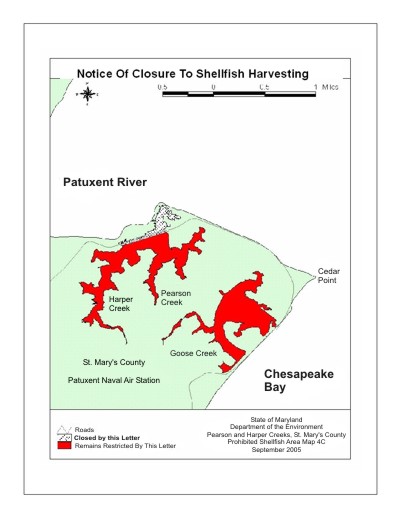BALTIMORE, MD (September 13, 2005) – Due to a recent evaluation of shellfish harvesting waters that shows unacceptable bacteria levels in the approved harvesting portion of Pearson Creek, the Maryland Department of the Environment (MDE) has issued a closure to shellfish harvesting effective today in a portion of the creek near the Patuxent Naval Air Station in St. Mary’s County. The area is used primarily as a near-shore aquaculture site. The closure will only impact shellfish harvesting (oysters and clams) and does not apply to swimming, fishing, or crabbing in the area.
“The law requires the department to close areas that do not meet the strict water quality standards necessary for shellfish harvesting waters,” said MDE Secretary Kendl P. Philbrick. “This action is necessary to prevent potential harmful effects from consumption of shellfish exposed to bacterial contamination. This action will assure the continuance of Maryland’s excellent reputation for wholesome shellfish products and maintain compliance with the National Shellfish Sanitation Program.”
A shoreline survey in the area adjacent to Pearson Creek of potential sources of bacteria contamination found no direct pollution sources. MDE will continue to investigate potential pollution sources and monitor shellfish water quality in Pearson Creek.
Portions of Pearson Creek were previously closed to harvesting and will remain closed. The shellfish harvesting waters will be re-opened when MDE determines that the shellfish and the waters again comply with the water quality standards for shellfish harvesting.
Growing oysters around docks, under bridges, and in other near-shore areas have a higher potential for elevated bacteria levels since these areas are more subject to pollution due to run-off, discharge of boat waste, limited circulation and flushing and other factors which may pose a threat to human health if oysters are harvested from these areas for human consumption. Docks and oyster floats can also be
attractive roosting areas for waterfowl. All of these factors have the potential to negatively affect water quality and the harvested shellfish.
Shellfish (oysters and clams) are filter feeders. They have the ability to filter the water around them and get food from the myriad of microscopic organisms found in the water column. If the waters are polluted, this filtering process can potentially include viruses or bacteria harmful to humans. Oysters and clams are often eaten raw or partially cooked and must come from waters that are not polluted. MDE monitors bacteriological water quality and conducts pollution source surveys to determine which areas are safe for the harvesting of shellfish.
Editor’s Note
A map of the area affected by the closure is available electronically below.

###